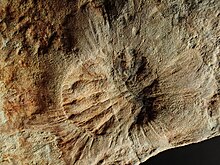| Palaeophragmodictya Temporal range: Late Ediacaran, 558–555 Ma PreꞒ Ꞓ O S D C P T J K Pg N ↓ | |
|---|---|

| |
| Fossil of P. spinosa | |
| Scientific classification | |
| Domain: | Eukaryota |
| Kingdom: | Animalia |
| Phylum: | Porifera |
| Class: | Hexactinellida |
| Order: | †Reticulosa |
| Genus: | †Palaeophragmodictya Gehling & Rigby, 1996 |
| Species | |
| |
Palaeophragmodictya is an extinct genus of sponge-grade organisms from the Ediacaran Period. Originally interpreted as a hexactinellid sponge, the organism also bears some coelomate characteristics, including bilateral symmetry.
Morphology
The organisms take the form of a rounded, dome-like bag, 7–68 mm in diameter, with an uneven margin. Radial grooves define sac-like compartments within the bag. The radial pattern has an element of bilateral symmetry. A stalk emerges from the central point of some specimens, at the top of the organism; in life, it probably extended into the water column. Ray-like filaments radiate outwards from the edge of the bag. Some structures in the organism have been interpreted as spicules.
Ecology
The organisms have been interpreted as tall suspension feeders, reaching 10 cm or more up into the sea water above them.
Original description
The genus was originally considered to be a member of the Dictyospongiidae family (hexactinellia), and was among the first Precambrian sponges to be described.
Distribution
First found in the Pound group of Australia, fossils have also been recovered from the White Sea region of Russia.
Other Sponge-Grade Ediacarans
See also
References
- ^ Gehling, J. G.; Rigby, J. K. (1996), "Long expected sponges from the Neoproterozoic Ediacara fauna of South Australia", Journal of Paleontology, 70 (2): 185–195, Bibcode:1996JPal...70..185G, doi:10.1017/S0022336000023283, ISSN 0022-3360, JSTOR 1306383
- ^ Serezhnikova, E. (2007), "Palaeophragmodictya spinosa sp. Nov., a bilateral benthic organism from the Vendian of the Southeastern White Sea Region", Paleontological Journal, 41 (4): 360–369, Bibcode:2007PalJ...41..360S, doi:10.1134/S0031030107040028, archived from the original on 2016-02-22, retrieved 2008-08-16
- Botting, J. P. (2007), ""Cambrian" demosponges in the Ordovician of Morocco: Insights into the early evolutionary history of …", Geobios, 40 (6): 737–748, Bibcode:2007Geobi..40..737B, doi:10.1016/j.geobios.2007.02.006
- Ivantsov, A. Y.; Malakhovskaya, Y. E.; Serezhnikova, E. A. (2004), "Some Problematic Fossils from the Vendian of the Southeastern White Sea Region" (PDF), Paleontological Journal, 38 (1): 1–9, archived from the original (PDF) on 2013-07-20
- Yuan, X.; Xiao, S.; Parsley, R. L.; Zhou, C.; Chen, Z.; Hu, J. (2002), "Towering sponges in an Early Cambrian Lagerstätte: Disparity between nonbilaterian and bilaterian epifaunal tierers at the Neoproterozoic-Cambrian transition", Geology, 30 (4): 363–366, Bibcode:2002Geo....30..363Y, doi:10.1130/0091-7613(2002)030<0363:TSIAEC>2.0.CO;2, ISSN 0091-7613
| Taxon identifiers | |
|---|---|
| Palaeophragmodictya | |
This prehistoric sponge article is a stub. You can help Misplaced Pages by expanding it. |